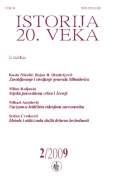Urbanizacija Međuratnog Beograda
Case Study In Urbanization Of Interwar Belgrade
Author(s): Ranka GašićSubject(s): History
Published by: Institut za savremenu istoriju, Beograd
Keywords: Belgrade; Modernisation; Urbanism; Urban culture
Summary/Abstract: Kotez Neimar is the first of the three Belgrade settlements built in accordance to the British 19th century concept of „garden city“, made in the conditions of rapid industrialization, and spread throughout Europe and further. Although quick and chaotic development of the interwar Belgrade was not caused by industrialization, local architects and urbanists were incited to offer solutions for more humane living conditions. Evolution of this part of the city is typical for legal, economical and demographical problems of the period. Population suffered due to the financial problems of the Belgrade Municipality, which was failing to honor its infrastructural obligations. On the other hand, inadequate legal regulations, private enterprise (in this case civil engineering company Neimar A.D), suffered from the consequences, and was liquidated in the end due to the debt. Quarrels over the expropriation of property which was designated for public space, as well as problems of widening the space of the Cubura creek (Southern boulevard today) faithfully depict conditions in which Belgrade was evolving after the First World War. However, Kotez Neimar was built in relatively short time, in less than eight years, but the communal infrastructure was significantly lagging behind. Villas in this neighborhood present coherent ambient, as many of them are important examples of Belgrade interwar architecture of all the styles of the time, and particularly modernism.
Journal: Istorija 20. veka
- Issue Year: 2009
- Issue No: 2
- Page Range: 53-66
- Page Count: 14
- Language: Serbian

